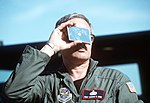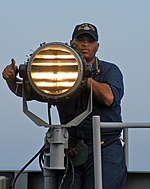Difference between revisions of "AY Honors/Morse Code/Answer Key"
Jomegat bot (talk | contribs) (Bot: Automated import of articles *** existing text overwritten ***) |
|||
| (2 intermediate revisions by the same user not shown) | |||
| Line 2: | Line 2: | ||
<section begin="Body" /> | <section begin="Body" /> | ||
{{ansreq|page={{#titleparts:{{PAGENAME}}|2|1}}|num=1}} | {{ansreq|page={{#titleparts:{{PAGENAME}}|2|1}}|num=1}} | ||
| − | <noinclude><translate></noinclude> | + | <noinclude><translate><!--T:16--> |
| + | </noinclude> | ||
<!-- 1. How is Morse code different from other codes? --> | <!-- 1. How is Morse code different from other codes? --> | ||
| + | [[File:International Morse Code.svg|thumb|right]] | ||
| + | Morse code is a method used in telecommunication to encode text characters as standardized sequences of two different signal durations, called ''dots'' and ''dashes'', or ''dits'' and ''dahs''. Morse code is named after [[w:Samuel_Morse|Samuel Morse]], one of the inventors of the telegraph. The ''dit'' duration is the basic unit of time measurement in Morse code transmission. The duration of a ''dah'' is three times the duration of a ''dit''. Each ''dit'' or ''dah'' within an encoded character is followed by a period of signal absence, called a ''space'', equal to the ''dit'' duration. The letters of a word are separated by a space of duration equal to three ''dits'', and words are separated by a space equal to seven ''dits''. | ||
| + | |||
| + | Morse code is different from other codes in that it can be memorized and sent in several forms perceptible to the human senses, e.g. vía sound waves or visible light, such that it can be directly interpreted by persons trained in the skill. Morse code is usually transmitted by [[w:On–off_keying|on-off keying]] of an information-carrying medium such as electric current, radio waves, visible light, or sound waves. | ||
| + | |||
| + | <!--T:17--> | ||
<noinclude></translate></noinclude> | <noinclude></translate></noinclude> | ||
{{CloseReq}} <!-- 1 --> | {{CloseReq}} <!-- 1 --> | ||
{{ansreq|page={{#titleparts:{{PAGENAME}}|2|1}}|num=2}} | {{ansreq|page={{#titleparts:{{PAGENAME}}|2|1}}|num=2}} | ||
| − | <noinclude><translate></noinclude> | + | <noinclude><translate><!--T:18--> |
| + | </noinclude> | ||
<!-- 2. What are the instruments used to communicate in Morse code? --> | <!-- 2. What are the instruments used to communicate in Morse code? --> | ||
| + | There are several instruments that can be used to communicate in Morse code. | ||
| + | |||
| + | [[File:J38TelegraphKey.jpg|thumb|left]] A [[w:Telegraph_key|telegraph key]] is a specialized electrical [[w:Switch|switch]] used by a trained operator to transmit text messages in Morse code in a [[w:Telegraphy|telegraphy]] system. Keys are used in all forms of [[w:Electrical_telegraph|electrical telegraph]] systems, including landline (also called wire) telegraphy and [[w:Wireless_telegraphy|radio (also called wireless) telegraphy]]. An operator uses the telegraph key to send electrical pulses (or in the case of modern [[w:Continuous wave#Radio|CW]], unmodulated radio waves) of two different lengths: short pulses, called ''dots'' or ''dits'', and longer pulses, called ''dashes'' or ''dahs''. These pulses encode the letters and other characters that spell out the message. | ||
| + | {{clear}} | ||
| + | [[File:Signal Mirror Plastic 3x5 StarFlash DF-SD-02-00923.JPEG|150px|thumb|right]] A simple and small mirror can also be used to transmit Morse code. By moving the mirror back and forth, and flashing with the use of a light source, like the sun. | ||
| + | {{clear}} | ||
| + | [[File:Seaman send Morse code signals.jpg|thumb|150px|left]] Toggling a light source is a visual method of sending Morse code. This can be doing by using different instruments that give off artificial light, such as a flashlight. | ||
| + | {{clear}} | ||
| + | |||
| + | <!--T:19--> | ||
<noinclude></translate></noinclude> | <noinclude></translate></noinclude> | ||
{{CloseReq}} <!-- 2 --> | {{CloseReq}} <!-- 2 --> | ||
{{ansreq|page={{#titleparts:{{PAGENAME}}|2|1}}|num=3}} | {{ansreq|page={{#titleparts:{{PAGENAME}}|2|1}}|num=3}} | ||
| − | <noinclude><translate></noinclude> | + | <noinclude><translate><!--T:20--> |
| + | </noinclude> | ||
<!-- 3. In a timeline and in a report of at least 300 words, tell the story of the creation of Morse code. Who used it initially? What was the reason for its creation and its use? --> | <!-- 3. In a timeline and in a report of at least 300 words, tell the story of the creation of Morse code. Who used it initially? What was the reason for its creation and its use? --> | ||
| + | <!--T:21--> | ||
<noinclude></translate></noinclude> | <noinclude></translate></noinclude> | ||
{{CloseReq}} <!-- 3 --> | {{CloseReq}} <!-- 3 --> | ||
{{ansreq|page={{#titleparts:{{PAGENAME}}|2|1}}|num=4}} | {{ansreq|page={{#titleparts:{{PAGENAME}}|2|1}}|num=4}} | ||
| − | <noinclude><translate></noinclude> | + | <noinclude><translate><!--T:22--> |
| + | </noinclude> | ||
<!-- 4. Describe the transmission of the following signs: --> | <!-- 4. Describe the transmission of the following signs: --> | ||
| + | <!--T:23--> | ||
<noinclude></translate></noinclude> | <noinclude></translate></noinclude> | ||
{{ansreq|page={{#titleparts:{{PAGENAME}}|2|1}}|num=4a}} <!--T:7--> | {{ansreq|page={{#titleparts:{{PAGENAME}}|2|1}}|num=4a}} <!--T:7--> | ||
| − | <noinclude><translate></noinclude> | + | <noinclude><translate><!--T:24--> |
| + | </noinclude> | ||
| + | <!--T:25--> | ||
<noinclude></translate></noinclude> | <noinclude></translate></noinclude> | ||
{{CloseReq}} <!-- 4a --> | {{CloseReq}} <!-- 4a --> | ||
{{ansreq|page={{#titleparts:{{PAGENAME}}|2|1}}|num=4b}} <!--T:8--> | {{ansreq|page={{#titleparts:{{PAGENAME}}|2|1}}|num=4b}} <!--T:8--> | ||
| − | <noinclude><translate></noinclude> | + | <noinclude><translate><!--T:26--> |
| + | </noinclude> | ||
| + | <!--T:27--> | ||
<noinclude></translate></noinclude> | <noinclude></translate></noinclude> | ||
{{CloseReq}} <!-- 4b --> | {{CloseReq}} <!-- 4b --> | ||
{{ansreq|page={{#titleparts:{{PAGENAME}}|2|1}}|num=4c}} <!--T:9--> | {{ansreq|page={{#titleparts:{{PAGENAME}}|2|1}}|num=4c}} <!--T:9--> | ||
| − | <noinclude><translate></noinclude> | + | <noinclude><translate><!--T:28--> |
| + | </noinclude> | ||
| + | <!--T:29--> | ||
<noinclude></translate></noinclude> | <noinclude></translate></noinclude> | ||
{{CloseReq}} <!-- 4c --> | {{CloseReq}} <!-- 4c --> | ||
{{ansreq|page={{#titleparts:{{PAGENAME}}|2|1}}|num=4d}} <!--T:10--> | {{ansreq|page={{#titleparts:{{PAGENAME}}|2|1}}|num=4d}} <!--T:10--> | ||
| − | <noinclude><translate></noinclude> | + | <noinclude><translate><!--T:30--> |
| + | </noinclude> | ||
| + | <!--T:31--> | ||
<noinclude></translate></noinclude> | <noinclude></translate></noinclude> | ||
{{CloseReq}} <!-- 4d --> | {{CloseReq}} <!-- 4d --> | ||
{{ansreq|page={{#titleparts:{{PAGENAME}}|2|1}}|num=4e}} <!--T:11--> | {{ansreq|page={{#titleparts:{{PAGENAME}}|2|1}}|num=4e}} <!--T:11--> | ||
| − | <noinclude><translate></noinclude> | + | <noinclude><translate><!--T:32--> |
| + | </noinclude> | ||
| + | <!--T:33--> | ||
<noinclude></translate></noinclude> | <noinclude></translate></noinclude> | ||
{{CloseReq}} <!-- 4e --> | {{CloseReq}} <!-- 4e --> | ||
{{CloseReq}} <!-- 4 --> | {{CloseReq}} <!-- 4 --> | ||
{{ansreq|page={{#titleparts:{{PAGENAME}}|2|1}}|num=5}} | {{ansreq|page={{#titleparts:{{PAGENAME}}|2|1}}|num=5}} | ||
| − | <noinclude><translate></noinclude> | + | <noinclude><translate><!--T:34--> |
| + | </noinclude> | ||
<!-- 5. Send and receive by the International Morse Code, a word or a Bible verse at a minimum rate of one letter for every five seconds, using a key, flashlight, whistle, mirror or speaker (words of approximately five letters, minimum 20 words). --> | <!-- 5. Send and receive by the International Morse Code, a word or a Bible verse at a minimum rate of one letter for every five seconds, using a key, flashlight, whistle, mirror or speaker (words of approximately five letters, minimum 20 words). --> | ||
| + | There are several free online Morse Code Translators. A few are [https://www.morsetranslator.com/ MorseTranslator.com], [https://morsedecoder.com/ MorseDecoder.com], and [https://morsecode.world/international/translator.html International Morse Code Translator] | ||
| + | |||
| + | <!--T:35--> | ||
<noinclude></translate></noinclude> | <noinclude></translate></noinclude> | ||
{{CloseReq}} <!-- 5 --> | {{CloseReq}} <!-- 5 --> | ||
{{ansreq|page={{#titleparts:{{PAGENAME}}|2|1}}|num=6}} | {{ansreq|page={{#titleparts:{{PAGENAME}}|2|1}}|num=6}} | ||
| − | <noinclude><translate></noinclude> | + | <noinclude><translate><!--T:36--> |
| + | </noinclude> | ||
<!-- 6. Make a creative picture to represent Morse code and its respective characters; it shoud include numbers, alphabet, and punctuation. --> | <!-- 6. Make a creative picture to represent Morse code and its respective characters; it shoud include numbers, alphabet, and punctuation. --> | ||
| + | <!--T:37--> | ||
<noinclude></translate></noinclude> | <noinclude></translate></noinclude> | ||
{{CloseReq}} <!-- 6 --> | {{CloseReq}} <!-- 6 --> | ||
<noinclude><translate></noinclude> | <noinclude><translate></noinclude> | ||
==References== <!--T:14--> | ==References== <!--T:14--> | ||
| − | + | * Wikipedia article on [[W:Morse Code|Morse Code]] | |
| − | |||
| − | [[ | ||
<noinclude></translate></noinclude> | <noinclude></translate></noinclude> | ||
{{CloseHonorPage}} | {{CloseHonorPage}} | ||
Latest revision as of 15:26, 27 December 2022
1
Morse code is a method used in telecommunication to encode text characters as standardized sequences of two different signal durations, called dots and dashes, or dits and dahs. Morse code is named after Samuel Morse, one of the inventors of the telegraph. The dit duration is the basic unit of time measurement in Morse code transmission. The duration of a dah is three times the duration of a dit. Each dit or dah within an encoded character is followed by a period of signal absence, called a space, equal to the dit duration. The letters of a word are separated by a space of duration equal to three dits, and words are separated by a space equal to seven dits.
Morse code is different from other codes in that it can be memorized and sent in several forms perceptible to the human senses, e.g. vía sound waves or visible light, such that it can be directly interpreted by persons trained in the skill. Morse code is usually transmitted by on-off keying of an information-carrying medium such as electric current, radio waves, visible light, or sound waves.
2
There are several instruments that can be used to communicate in Morse code.
A telegraph key is a specialized electrical switch used by a trained operator to transmit text messages in Morse code in a telegraphy system. Keys are used in all forms of electrical telegraph systems, including landline (also called wire) telegraphy and radio (also called wireless) telegraphy. An operator uses the telegraph key to send electrical pulses (or in the case of modern CW, unmodulated radio waves) of two different lengths: short pulses, called dots or dits, and longer pulses, called dashes or dahs. These pulses encode the letters and other characters that spell out the message. A simple and small mirror can also be used to transmit Morse code. By moving the mirror back and forth, and flashing with the use of a light source, like the sun. Toggling a light source is a visual method of sending Morse code. This can be doing by using different instruments that give off artificial light, such as a flashlight.
3
4
4a
4b
4c
4d
4e
5
There are several free online Morse Code Translators. A few are MorseTranslator.com, MorseDecoder.com, and International Morse Code Translator
6
References
- Wikipedia article on Morse Code







